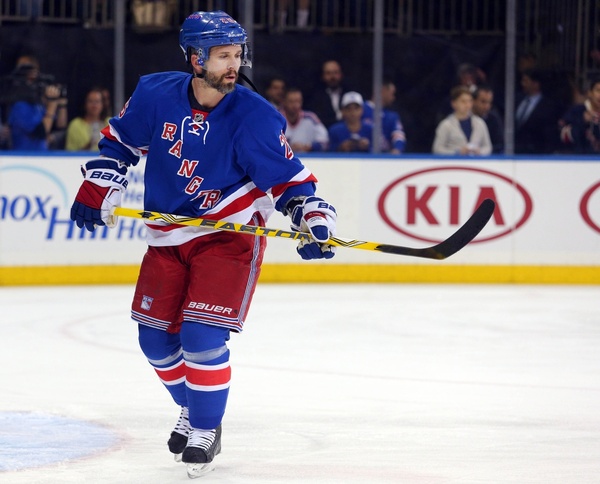Top-10 UFA countdown: #8 – Martin St. Louis

Photo Credit: Brad Penner/USA TODAY Sports
This is a series counting down the top-10 pending UFAs. It will be posted across the Nation Network over the next month! Enjoy!
Over the course of Martin St. Louis‘ Hall of Fame worthy career the 5-foot-8 winger has won a Hart Trophy, a Stanley Cup, an Olympic Gold Medal and two Art Ross trophies (including one as a 37-year-old). His resume is beyond reproach.
Built like a bumper car, St. Louis has accomplished everything a hockey player can accomplish. And as much as hockey’s trend watchers are fawning over undersized players now, St. Louis has been doing Tyler Johnson-like things for more than a decade. So how can a future Hall of Fame immortal find himself ranked eighth on our countdown of the top unrestricted free agents?
It’s simple really: age catches up to everyone, even the best among us, and St. Louis will turn 40 this month. Thanks to a variety of advances in the field of human performance, players are remaining effective for longer, and no one doubts St. Louis’ work ethic or ability to be an outlier, but St. Louis’ advancing age combined with his least productive offensive season in 13 years is sure to dampen the enthusiasm with which he’s pursued on the free agent market this summer.
Track Record
St. Louis’ track record is sterling.
Age aside, this is still a player that’s only three years removed from winning the Art Ross trophy. He’s 16 months removed from playing for Canada’s Gold Medal winning 2014 men’s Olympic ice hockey team – the most dominant international hockey squadron in hockey history.
This past season, St. Louis’ least productive in 13 years, he still scored at a first-line rate. The 39-year-old was a top-50 NHL forward by goal scoring rate and 5-on-5 points per 60 minutes, and he remains a first-line caliber set up man. On the power-play, St. Louis wasn’t used that often, but he finished 75th in scoring efficiency among all NHL forwards who logged at least 150 5-on-4 minutes, which would suggest he still probably belongs on a first power-play unit somewhere.
Though St. Louis was second among all Rangers forwards in even-strength ice time per game, his usage declined somewhat in the postseason, as he was bumped to the Rangers’ third-line. I’d argue that this was partly for matchup reasons though, as Alain Vigneault constructed a speed-based third line featuring St. Louis, Carl Hagelin, and Dominic Moore, to try and take advantage of the slower depth defenders on the Tampa Bay Lightning.
From his ice time to his still strong scoring rates, the wheels haven’t really fallen off St. Louis yet. He remains a good bet to perform like a first-line caliber forward, albeit not an elite one.
Future Performance
Though St. Louis still logs major minutes and remains productive, there are signs of the toll that advancing age has had on his game.
He drew penalties at a lower rate than he has at any time since the dawn of the BehindtheNet era this season, and his underlying results – which have been stagnating for some time – continued to slide. St. Louis is at the stage of his career where he’s reliant on favourable percentages to drive his production, not to mention a positive on-ice goal differential.
The good news on this front is that St. Louis still qualifies as that rare player who does legitimately drive percentages. St. Louis has pretty much always carried a high on-ice shooting percentage, and that’s continued into his late-30s.
Since the NHL lockout, only seven regular NHL forwards have managed a higher on-ice shooting percentage in 5-on-5 situations and they’re mostly the names you’d expect (Thomas Vanek, Jiri Hudler, Ryan Getzlaf and Corey Perry etc.). That St. Louis’ percentage driving ability has persisted, even after he moved on from playing regular shifts with one of the game’s best shooters in Steven Stamkos, is a good sign.
At this point in St. Louis’ career no one should be gambling on him remaining effective for years and years to come, but if you’re betting that he can be a helpful secondary offensive option for next season, that seems a sensible enough wager – if the price is right.
Contract outlook
Because of St. Louis’ age, his declining effectiveness, and the NHL’s 35+ rule, the veteran forward is unlikely to command much in the way of term on the open market. Surely he’ll be hard pressed to land the sort of contract that Jarome Iginla received from the Colorado Avalanche.
In terms of St. Louis’ salary for next season though (or even, perhaps, for the year after), he’s still probably a $5-6 million player.
Surely St. Louis will be able to match the contract that the Vancouver Canucks signed Radim Vrbata to last summer. Vrbata is nearly seven years younger than St. Louis, but was coming off of a less productive contract year than the one St. Louis just authored in New York.
Don’t be surprised if St. Louis lands somewhere on something like a two-year, $12 million deal. That’s a hefty bet – particularly in the second year of the contract – but it’s tough to add first-line caliber forwards in free agency without a longer term commitment.
It should go without saying that if St. Louis decides to chase another Stanley Cup and sign with a contender on a cheap one-year deal, he could be a massive steal. Of course, if that’s what St. Louis decides to do, then it would seem likely that he’d just remain with the Rangers.
He’s also been linked to the New Jersey Devils, who could certainly use some of St. Louis’ latent fire power up front.
Recent articles from Thomas Drance




